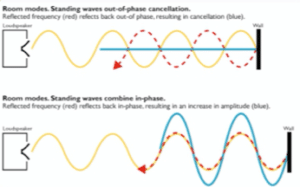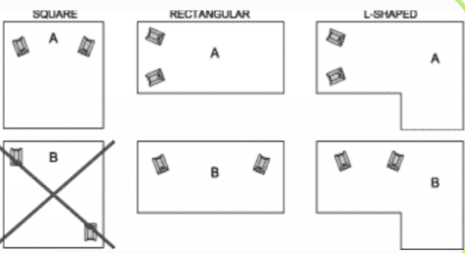Acoustics: The Basics
Room Shape
The diagram depicted below illustrates three of the more typical room shapes: square, rectangular and L-shaped rooms. The most favourable positioning of the speakers within each space is shown.
Uniformly square rooms are the least desirable room shapes for speaker orientations, since the production of standing waves within these environments are the most efficient – but for our purposes, the least productive.
Rooms that are narrow and rectangular also produce undesirable standing waves, creating several along their length. Whilst you might obtain maximum low frequency response by positioning your speakers along the narrow wall of this type of room, you will achieve an optimal mid-range clarity and stereo imaging by positioning your monitors across the longer wall.
You might reason that rooms that are L-shaped will create the same problems that are presented with rectangular rooms, essentially being comprised of two adjoining rectangles, yet this acoustical asymmetry has the effect of breaking up the standing waves to afford an altogether enhanced listening location.
We have talked extensively about the ways in which various pieces of technical equipment should be exploited to achieve uniform mixes that translate across the board, but one of the most important factors will be the actual recording space itself. A mix can be engineered to a room that suffers from poor acoustics, but again, when playing back the mix in a different environment, it can sound very different – and often not very good at all.
If the acoustics of the room suffer from minor problems then the mix will probably reflect this in differences in the bass or treble content, but can, in severe cases, cause the balance to fall apart, or can reveal elements that could not be heard in your original mix-down. A room, like your monitors, can be biased in terms of certain frequencies and, as such, may be bass-light or heavy, or otherwise. As with perceived monitor bias, you will naturally be inclined to compensate for these supposed anomalies and, whilst sounding great within your environment, these will nevertheless be exposed in other listening situations. Your only real concern here is that your room works for creating mixes that translate through to the other range of systems and conditions that they will ultimately be subjected to.
When we are talking of acoustic treatment it is important to understand that this has little to do with the process of soundproofing. It is a common misconception that the two are one and the same, but this is not the case. Soundproofing is only concerned with reducing or eliminating the amount of sound that gets in or out of the recording space, but will do nothing to improve or define the room’s unique recording or listening characteristics. That is why, on top of soundproofing, you may also need to undertake a degree of acoustic treatment.
No amount of money splashed on expensive equipment will compensate for a poor acoustic environment; even the finest speakers in the world cannot guarantee a perfect monitoring arrangement if the room is acoustically compromised. Take heed then: the room itself needs to be considered as part of the whole recording environment. Considering the room as part of the equation itself, the old adage still stands: you are only as strong as your weakest link.
So what exactly do we mean by the ‘sound’ of a room when it is the speakers that actually produce the sound? Well, the answer lies in the fact that even after the speakers have stopped emitting sound, the waves continue into the room and are reflected off solid surfaces until their energy is eventually absorbed. The relationship between the room, speakers and orientation are intertwined with each other, with all components combining to create the resulting soundscape. If you were to set up your speakers outside, you would be creating what is termed an ‘anechoic’ environment, whereby there would be nothing to reflect the soundwaves and cause reflections and reverberations in the overall sound quality. The bass, mids and tops would sound remarkably clean and tight without these conflicting echoes, but unfortunately these kinds of outdoor environments are usually only seen at festivals and are not readily translated into the studio.
With the exception of the iPod, one of the most popular places for listening to music is still in the car and many engineers will reference their mixes on the car’s system. In fact, there are some good reasons why the car should prove to be such a reliable place to check you final mixes:
- · The shape of a car creates an ideal space for listening because the walls are thin and curved and are not parallel to each other.
- · The speakers are nearly always mounted into a flat surface into the sides of doors, which means that there are no out-of-phase signals that are reflected back into the listening space.
- · High frequencies – in the car the windows are the main high-frequency reflectors but they are all at angles and are usually curved as well. The highs also get diffused evenly throughout the cabin by the
dashboard. Also the ceiling, sides and floor are covered in high-frequency absorbing materials.
- · Again the seats, door panels and passengers themselves act as good mid absorbers and in fact a car will have had acoustic treatment already to help reduce the amount of noise pollution from the engine and road traffic noise.
-
· The best bit about the car’s inherent acoustics is, in my opinion, the bass response. A couple of hundred watts each side and a sub-woofer in the boot or under the seat will sound absolutely fantastic. The majority of the low-end dissipates straight through the roof and walls, and so you do not get any of the negative effects of phase shifting lingering around. As far as the bottom-end is concerned, the car is equivalent to being out in the open and that, in fact, is what you will hear from listening outside of one – not the tops or mids, but the thumping bass emanating from the woofer.
So the lesson here is if you want to create fantastic sounding mixes, then give your room the same kind of acoustic treatment as your car! Well, not quite the same, but the principle remains the same and many engineers swear that the acoustics of their room will make all the difference to the final mix – and this will be a far more important component to achieving your perfect mix-down than the latest plug-in or FX unit!
Before we take a look at the practical methodology of acoustic treatment, we shall spend a bit of time considering the theoretical reasons why and how a room can interfere with the soundwaves coming from your speakers.
RT 60?
In the late 19th century, Wallace Clement Sabine started experiments at Harvard University to investigate the impact of absorption on the reverberation time. Using a portable wind chest and organ pipes as a sound source, a stopwatch and his ears, he measured the time from interruption of the source to inaudibility (roughly -60 dB). He found that the reverberation time is proportional to the dimensions of room and inversely proportional to the amount of absorption present. RT60 is the time required for reflections of a direct sound to decay by 60 dB below the level of the direct sound.

Ideally, a good listening environment will require a small amount of reverb, not only to increase the perceived loudness of the monitoring system, but also to avoid the space from sounding abnormally dead. If we wish to avoid colouration of the sound, however, we need to ensure that the reverb time is equal over all of the frequencies of the audio spectrum. For control rooms, this will typically be a reverb decay of between 0.3 and 0.5 seconds. However, the optimum reverberation time for a space in which music is played does depend on the type of music that is to be played in the space.
Basic factors that affect a room’s reverberation time include the size and shape of the enclosure as well as the materials used in the construction of the room. Every object placed within the enclosure can also affect this reverberation time, including people and their belongings.
Standing Waves

Standing waves are non-travelling vibrations of a certain wavelength and frequency, which occur on a medium of a certain size. The size of the medium controls the wavelengths of the standing waves. Also, the way that the medium is held at its ends, either fixed or open, controls the wavelengths of the standing waves. In the studio environment, what you need to understand is that standing waves are created when you have two parallel facing walls. The dimensions of the room are critical in determining which frequencies will create these types of waves. In other words, if the soundwave that is being emitted is equal in length to the longest dimension of the room, it will be reflected back and forth in phase with the original wave and thus, reinforce it.


